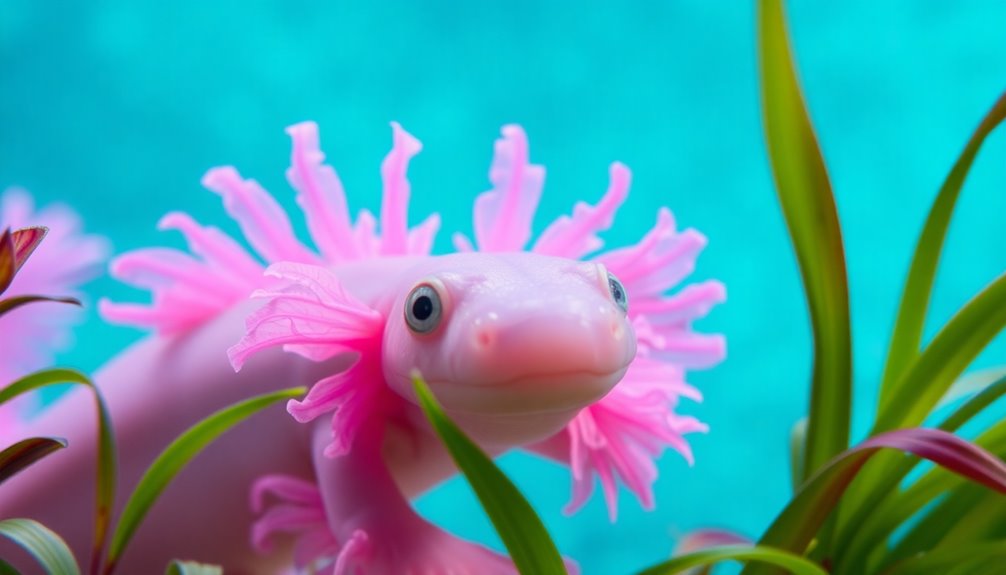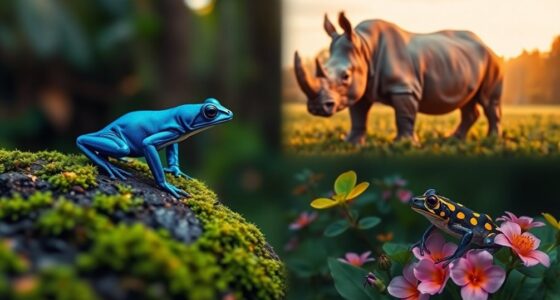You're about to meet the coconut crab, the world's largest terrestrial arthropod. Growing up to three feet in length and weighing nearly nine pounds, this remarkable creature amazes with its climbing skills. It can scale trees looking for coconuts, which it cracks open with powerful pincers. By night, these nocturnal crabs forage for food in coastal areas and lush forests. Unfortunately, they face threats from habitat loss and climate change. Understanding its unique role in the ecosystem is essential. Stick around, and you'll uncover more fascinating details about this incredible animal and its challenges.
Key Takeaways
- The coconut crab, or Birgus latro, is the largest terrestrial arthropod, reaching up to 3 feet in length and 9 pounds in weight.
- Known for its incredible climbing abilities, the coconut crab can scale trees up to 3 meters high to access coconuts.
- With powerful pincers, it can crack open coconuts, showcasing unique adaptations that contribute to its survival.
- Primarily nocturnal, coconut crabs engage in foraging and exploration at night, adding to their intriguing behavior.
- Classified as Vulnerable, conservation efforts are crucial to protect their habitats and ensure their ecological role is preserved.
Overview of the Coconut Crab
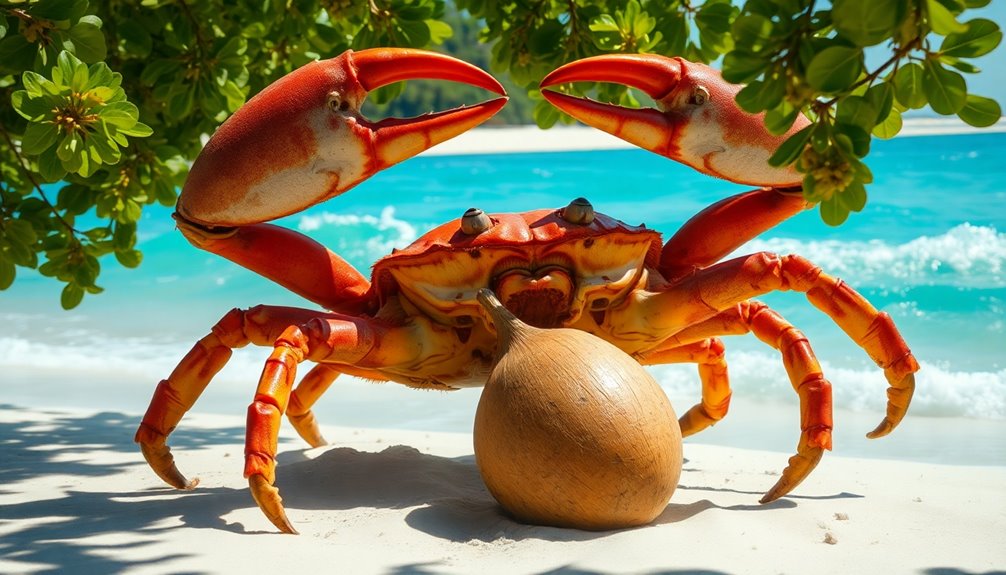
When you think of unusual creatures, the coconut crab often stands out due to its remarkable size and unique behaviors. This incredible animal species, scientifically known as Birgus latro, is the largest terrestrial arthropod, reaching up to 3 feet in length and weighing as much as 9 pounds.
What's fascinating is its impressive climbing ability; coconut crabs can ascend trees to access their primary food source—coconuts.
Unfortunately, these remarkable creatures face threats from habitat loss and overharvesting, prompting various conservation efforts to protect their populations.
Unique Features and Abilities
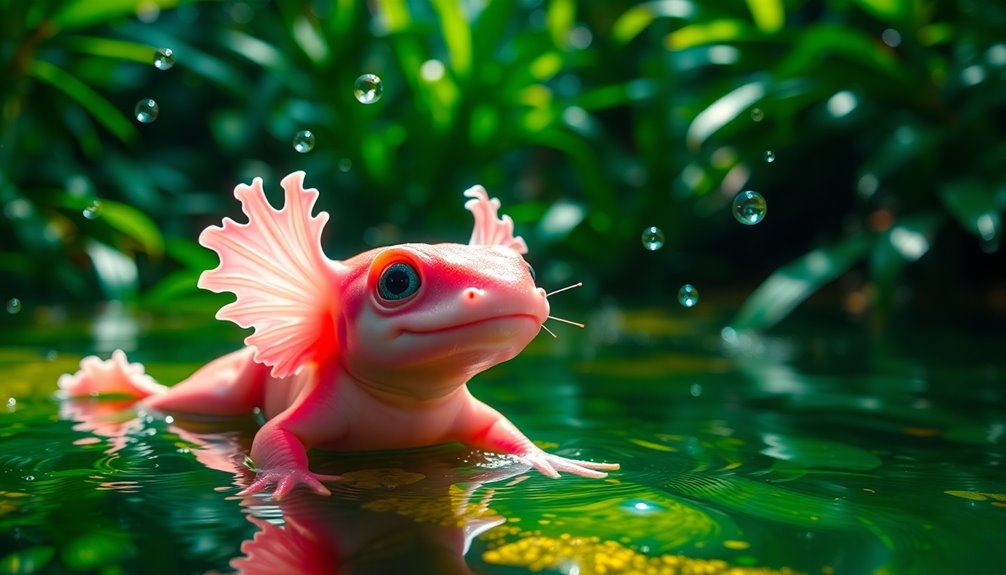
The coconut crab's climbing abilities are truly remarkable, allowing it to scale trees with ease.
You'll be fascinated by its powerful pincers, which can crack open coconuts like a pro.
Plus, its unique nocturnal behavior means it's on the move when most of us are asleep, adding to its intriguing nature.
Climbing Capabilities in Trees
Coconut crabs showcase some of the most impressive climbing abilities among terrestrial animals, often scaling trees up to 3 meters high.
Their remarkable climbing capabilities allow them to search for food and find shelter in the trees that call home. Equipped with strong pincers, you'll see these agile creatures grasping onto tree bark, deftly maneuvering to reach delicious coconut fruits.
Their nocturnal nature means they climb primarily at night, avoiding the day's heat and reducing competition for food. This adaptability not only aids in foraging but also provides a safe refuge from predators, enhancing their survival in the wild.
In a diverse animal kingdom, the climbing prowess of coconut crabs truly sets them apart.
Powerful Coconut-Cracking Pincers
With their impressive strength and adaptability, coconut crabs have evolved powerful pincers that can crack open hard coconut shells with ease. These pincers aren't just for feeding; they also act as a defense mechanism against predators, showcasing their essential role in survival.
Even though these crabs thrive in various habitats, their strength is partly due to their robust exoskeleton, which supports them during the molting process. Coconut crabs can lift weights several times their body mass, proving their remarkable capabilities.
They can even climb trees using these pincers, allowing them to access higher food sources and evade ground threats. These adaptations are critical, especially in environments where oxygen levels may fluctuate, impacting their overall health and activity.
Unique Nocturnal Behavior
While many animals are active during the day, coconut crabs thrive under the cover of night, engaging in unique behaviors that enhance their survival.
During these hours, they forage and scavenge, skillfully avoiding daytime predators and the harsh heat. With their powerful pincers, they crack open coconuts, accessing food sources that most animals can't reach.
Their excellent sense of smell helps them locate food from far away, guiding them through the dark. You might be surprised to see them climbing trees, using their nocturnal activity to find sustenance high above ground.
When the sun rises, they burrow into sandy soil, creating shelters that protect them from threats while they rest during the day.
Habitat Preferences
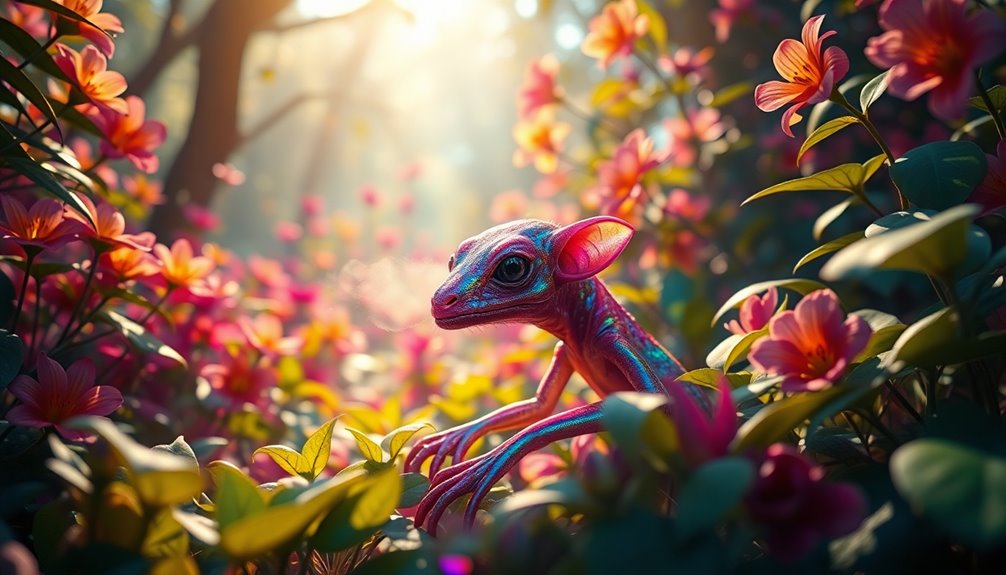
Coconut crabs thrive in coastal areas and lush forests, making these unique habitats essential for their survival.
You'll find them burrowing in sandy soil, which offers protection from predators and a cozy place to call home.
Understanding their habitat preferences reveals how vulnerable they're to environmental changes and human impact.
Coastal Areas Preference
Coastal areas play an essential role in the survival of coconut crabs, as they thrive in habitats with sandy or loose soil ideal for burrowing.
You'll often find these fascinating crabs on remote islands in the Pacific and Indian Oceans, like Christmas Island and Guam. They prefer forests that border coastlines, where they can easily find food and shelter.
Their sensitivity to environmental changes makes these coastal habitats critical for breeding and feeding, ensuring their populations remain stable.
However, habitat loss from urban development poses a significant threat to their survival. Protecting these coastal ecosystems is important not just for coconut crabs, but for maintaining the balance of marine life in these unique environments.
Forested Environments Adaptation
Although these fascinating creatures are often associated with coastal regions, they also show remarkable adaptability to forested environments.
The coconut crab thrives on remote islands in the Pacific and Indian Oceans, where it prefers sandy or loose soil for burrowing. These burrows provide shelter from predators and harsh conditions, making them essential for survival.
Exhibiting nocturnal behavior, you'll find coconut crabs foraging for food at night in these lush habitats. Their unique ability to climb trees allows them to access coconuts, a primary food source.
However, habitat loss due to urban development and climate change threatens their existence, highlighting the urgent need for conservation efforts to protect these extraordinary arthropods and their diverse environments.
Shelter in Burrows
When it comes to finding shelter, coconut crabs show a strong preference for burrowing in sandy or loose soil, which offers protection from predators and harsh environmental conditions.
You'll often find their burrows in coastal areas and forests, providing easy access to food and safe nesting spots. These crabs are quite sensitive to environmental changes, so their burrowing habits are essential for survival in fluctuating habitats.
Burrows also help regulate temperature and humidity, critical for the crab's well-being and molting process.
Unfortunately, urban development and climate change are reducing suitable burrowing habitats, posing a significant threat to coconut crab populations.
Protecting these environments is fundamental for ensuring the future of these amazing creatures.
Distribution Across the Globe
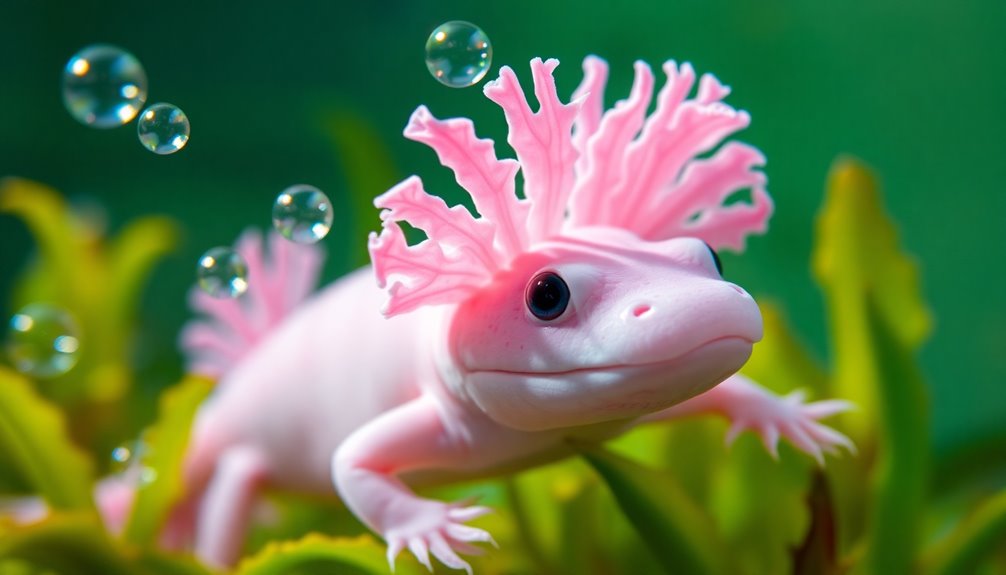
The Coconut Crab, fascinating in both size and behavior, is primarily found on remote islands in the Pacific and Indian Oceans, with notable populations around Christmas Island and Guam.
These incredible creatures thrive in coastal areas and forests, often burrowing in sandy or loose soil for shelter. Their distribution is limited to specific tropical and subtropical regions, making them sensitive to environmental changes.
You'll often spot them climbing trees in search of food, showcasing their impressive agility.
However, habitat loss due to urban development and climate change is considerably impacting their populations. This vulnerability highlights the need for conservation efforts to protect their unique habitats and guarantee the survival of the world's largest terrestrial arthropod.
Behavior and Lifestyle
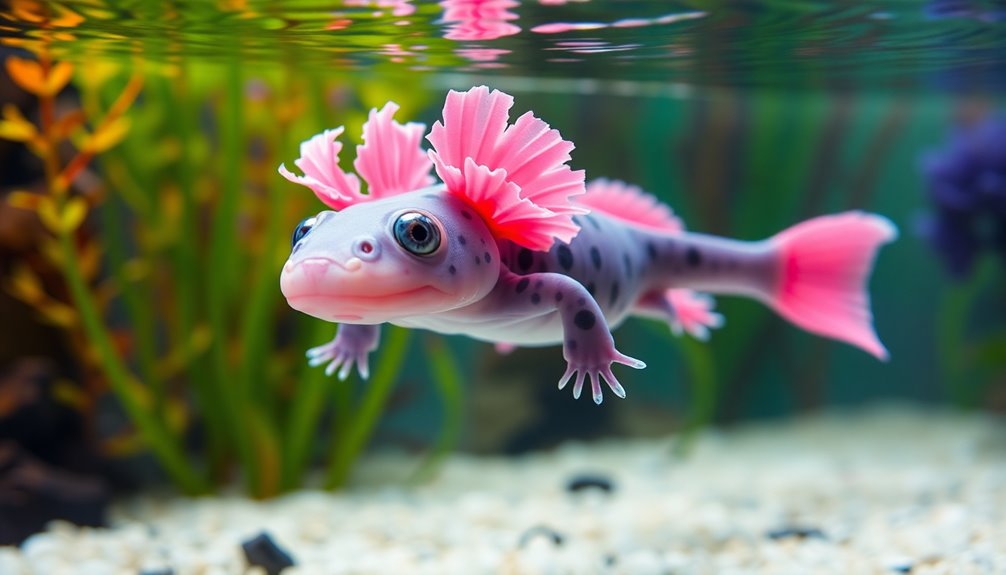
Coconut crabs engage in a fascinating lifestyle that revolves around their nocturnal habits and social interactions. Active mainly at night, you'll find them foraging for food, climbing trees, and exploring their environment.
As scavengers, they enjoy a diverse diet, munching on fruits, nuts, and even the remains of dead animals. Their impressive climbing skills allow them to ascend trees to reach coconuts, which they crack open using their powerful pincers.
During mating season, you might observe these social creatures interacting with one another, showcasing their complex behaviors.
Additionally, coconut crabs undergo a molting process, shedding their exoskeletons to grow, an essential aspect of their development and survival in the wild.
Conservation Status and Challenges
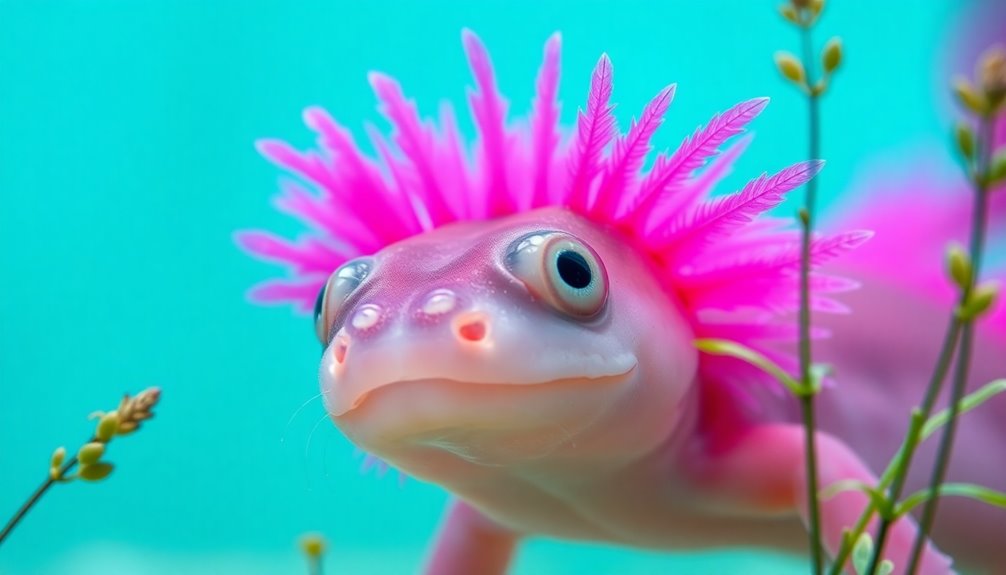
While many people enjoy the taste of coconut crabs, their conservation status is increasingly concerning. The IUCN lists them as vulnerable, highlighting the risk to their populations.
Overharvesting for food is a major challenge, especially in areas where they're considered a delicacy, leading to a rapid decline in numbers. Additionally, habitat destruction from urban development has destroyed essential coastal and forest environments that these crabs depend on.
Climate change further complicates matters by altering their habitats, affecting food sources, and increasing extreme weather events.
To combat these challenges, conservation efforts focus on protecting their habitats, promoting sustainable harvesting practices, and raising awareness about their ecological importance.
Without these measures, we risk losing these fascinating creatures.
Importance of Protection Efforts

Protecting the coconut crab is essential not only for their survival but also for the health of the ecosystems they inhabit. With their vulnerable status, these crabs face threats from overharvesting and habitat destruction due to urban development.
You can help by supporting conservation efforts that prioritize habitat protection and promote sustainable practices. Climate change also poses a serious risk, making proactive strategies vital for their survival.
Engaging local communities in these initiatives enhances the management of resources, ensuring the coconut crab's future. Your involvement can drive positive change, fostering awareness and action.
Frequently Asked Questions
What Is the World's Weirdest Animal?
When you think about the world's weirdest animal, the axolotl might come to mind. This fascinating amphibian never fully matures, keeping its larval traits throughout life.
You'll be amazed by its external gills and incredible ability to regenerate limbs. If that doesn't impress you, consider the platypus, which lays eggs and has a duck-like bill.
Each of these unique creatures showcases nature's creativity and adaptability in surprising ways.
What Is the Weirdest Animal in the World in 2024?
Imagine a creature that looks like a swimming blob, its gelatinous body floating effortlessly in the deep sea.
In 2024, many still consider the blobfish the weirdest animal in the world. With its squishy appearance and ability to endure crushing ocean pressures, it defies conventional beauty.
Yet, don't overlook the axolotl, an enchanting amphibian with the power to regrow limbs.
Both embody nature's quirky wonders, captivating your curiosity about the animal kingdom.
What Is the Funniest Looking Creature?
When you think about the funniest looking creature, the Axolotl definitely comes to mind. Its feathery gills and wide grin create a quirky appearance that'll make you smile.
This unique amphibian stays in its larval form forever, which adds to its charm. Plus, its ability to regenerate limbs is as fascinating as its looks.
You can't help but love this goofy little creature, often enchanting both scientists and pet lovers alike!
What Is an Animal That Nobody Knows About?
You might be surprised to learn about the Saola, often dubbed the "Asian unicorn."
Discovered in 1992, this elusive creature hides in the dense forests of Vietnam and Laos.
With fewer than 750 left in the wild, it's critically endangered, and many people are unaware of its existence.
Its striking looks and rarity make it a fascinating subject for wildlife enthusiasts.
Conclusion
Just like the coconut crab, you're a unique creature traversing your own habitat. Embrace your quirks, for they set you apart in a world of conformity. As you scuttle through life, remember that protecting your environment—both internal and external—ensures your survival. Just as the coconut crab needs conservation efforts to thrive, you too need to safeguard your individuality and the spaces you cherish. Celebrate your weirdness; it's what makes you truly remarkable.
